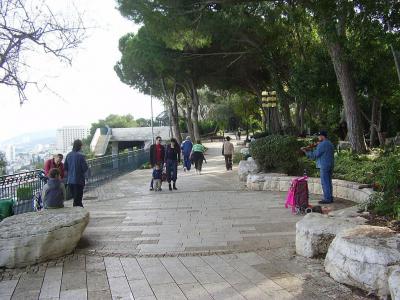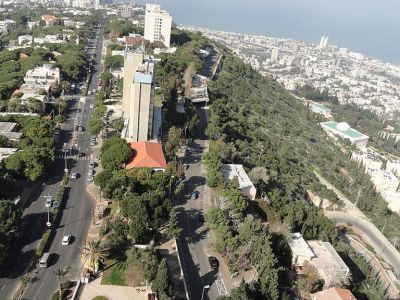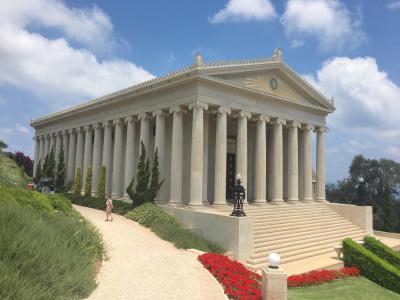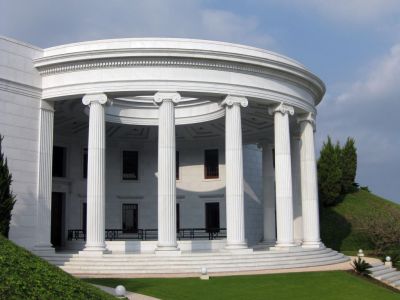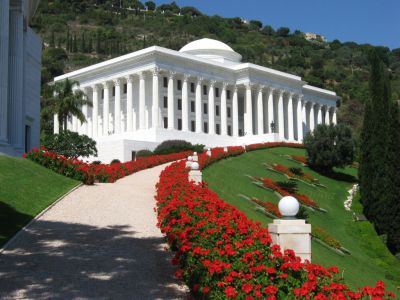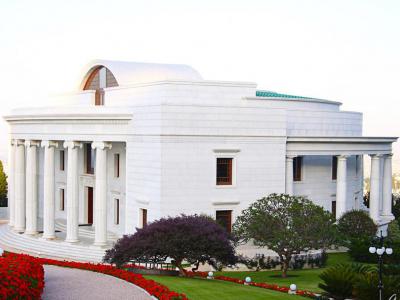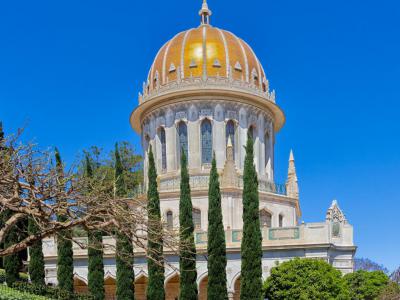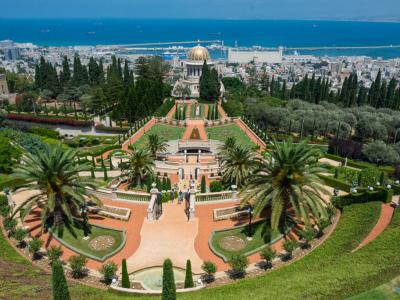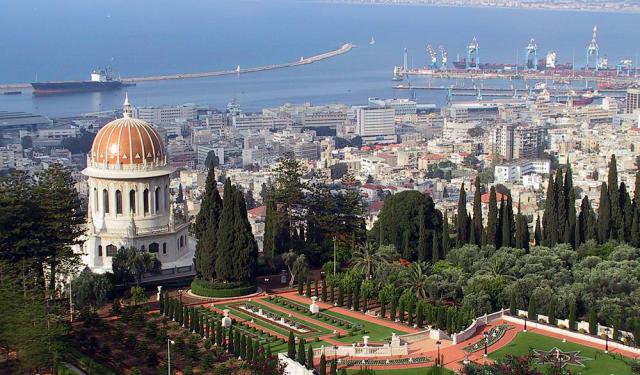Bahai World Center Tour (Self Guided), Haifa
The Bahai Faith is a monotheistic religion that stemmed from Shiʻa Islam in the 19th century. Since its emergence, the religion has spread its influence to many parts of the world, with its spiritual and administrative center established in Israel.
The Bahai World Centre in Haifa is a religious complex that comprises several buildings, the most notable of which is the Shrine of the Bab, a holy site containing the remains of the Bab, one of the central figures of the Faith. Located on Mount Carmel, the intricately decorated golden-domed Shrine is considered one of the most beautiful religious buildings in the world.
The surrounding terraced gardens, sloping down from the Shrine towards the city and the Mediterranean Sea are meticulously landscaped and designed to symbolize the unity of humanity and the harmony between nature and religion. Bahaʼu'llah, the founder of the Bahai Faith, used to say: “The utterance of God is a lamp, whose light is these words: Ye are the fruits of one tree, and the leaves of one branch. Deal ye one with another with the utmost love and harmony, with friendliness and fellowship. So powerful is the light of unity that it can illuminate the whole earth.”
Other important buildings in the Center include the Universal House of Justice, which is the international governing body of the Bahai Faith, and the International Teaching Centre, which is responsible for the training of Bahai teachers. Indeed, according to Bahaʼu'llah, “Knowledge is as wings to man's life, and a ladder for his ascent. Its acquisition is incumbent upon everyone.”
The located on the site Archives building is where the historical and sacred documents of the Bahai Faith are kept. The Bahai complex is open to visitors of all faiths, receiving thousands of visitors annually. However, some areas may have restricted access for Bahai pilgrims or during certain times of the year.
If you wish to explore the most popular Bahai places in Haifa on your own, take this self-guided walking tour.
The Bahai World Centre in Haifa is a religious complex that comprises several buildings, the most notable of which is the Shrine of the Bab, a holy site containing the remains of the Bab, one of the central figures of the Faith. Located on Mount Carmel, the intricately decorated golden-domed Shrine is considered one of the most beautiful religious buildings in the world.
The surrounding terraced gardens, sloping down from the Shrine towards the city and the Mediterranean Sea are meticulously landscaped and designed to symbolize the unity of humanity and the harmony between nature and religion. Bahaʼu'llah, the founder of the Bahai Faith, used to say: “The utterance of God is a lamp, whose light is these words: Ye are the fruits of one tree, and the leaves of one branch. Deal ye one with another with the utmost love and harmony, with friendliness and fellowship. So powerful is the light of unity that it can illuminate the whole earth.”
Other important buildings in the Center include the Universal House of Justice, which is the international governing body of the Bahai Faith, and the International Teaching Centre, which is responsible for the training of Bahai teachers. Indeed, according to Bahaʼu'llah, “Knowledge is as wings to man's life, and a ladder for his ascent. Its acquisition is incumbent upon everyone.”
The located on the site Archives building is where the historical and sacred documents of the Bahai Faith are kept. The Bahai complex is open to visitors of all faiths, receiving thousands of visitors annually. However, some areas may have restricted access for Bahai pilgrims or during certain times of the year.
If you wish to explore the most popular Bahai places in Haifa on your own, take this self-guided walking tour.
How it works: Download the app "GPSmyCity: Walks in 1K+ Cities" from Apple App Store or Google Play Store to your mobile phone or tablet. The app turns your mobile device into a personal tour guide and its built-in GPS navigation functions guide you from one tour stop to next. The app works offline, so no data plan is needed when traveling abroad.
Bahai World Center Tour Map
Guide Name: Bahai World Center Tour
Guide Location: Israel » Haifa (See other walking tours in Haifa)
Guide Type: Self-guided Walking Tour (Sightseeing)
# of Attractions: 8
Tour Duration: 1 Hour(s)
Travel Distance: 1.8 Km or 1.1 Miles
Author: DanaOffice
Sight(s) Featured in This Guide:
Guide Location: Israel » Haifa (See other walking tours in Haifa)
Guide Type: Self-guided Walking Tour (Sightseeing)
# of Attractions: 8
Tour Duration: 1 Hour(s)
Travel Distance: 1.8 Km or 1.1 Miles
Author: DanaOffice
Sight(s) Featured in This Guide:
- Louis Promenade
- Yefe Nof Street
- International Archives
- Centre for the Study of the Sacred Texts
- Universal House of Justice
- International Teaching Centre
- Shrine of the Báb
- Hanging Gardens (Terraces of the Bahá'í Faith)
1) Louis Promenade (must see)
Perched on the scenic slopes of Mount Carmel in Haifa, the Louis Promenade offers a breathtaking vantage point from which to soak in the captivating beauty of the city and its surroundings. As a popular spot for both locals and tourists alike, the promenade provides a serene and picturesque escape from the bustling urban life, inviting visitors to relax, unwind, and immerse themselves in the stunning panoramas that unfold before their eyes.
Named after the philanthropist Louis Wirth, who contributed significantly to the development of Haifa, the Louis Promenade stretches approximately 400 meters in length and is lined with an array of lush trees and colorful flower beds, creating a tranquil and inviting atmosphere. The landscaped walkway is meticulously designed to showcase the unparalleled views of Haifa's cityscape, the expansive Mediterranean Sea, and the sweeping vistas of the Galilee region.
As visitors stroll along the promenade, they are treated to a visual feast that includes iconic Haifa landmarks such as the Baha'i Gardens, the Shrine of the Báb, and the Port of Haifa. The promenade is also an ideal location to witness magnificent sunsets, as the sky is painted with hues of gold, pink, and purple, casting a warm glow over the city.
In addition to its visual appeal, the Louis Promenade serves as a vibrant social space where families and friends gather for picnics, leisurely strolls, and informal gatherings. It also hosts occasional cultural events, such as open-air concerts and art exhibitions, further enriching the experience for visitors.
Named after the philanthropist Louis Wirth, who contributed significantly to the development of Haifa, the Louis Promenade stretches approximately 400 meters in length and is lined with an array of lush trees and colorful flower beds, creating a tranquil and inviting atmosphere. The landscaped walkway is meticulously designed to showcase the unparalleled views of Haifa's cityscape, the expansive Mediterranean Sea, and the sweeping vistas of the Galilee region.
As visitors stroll along the promenade, they are treated to a visual feast that includes iconic Haifa landmarks such as the Baha'i Gardens, the Shrine of the Báb, and the Port of Haifa. The promenade is also an ideal location to witness magnificent sunsets, as the sky is painted with hues of gold, pink, and purple, casting a warm glow over the city.
In addition to its visual appeal, the Louis Promenade serves as a vibrant social space where families and friends gather for picnics, leisurely strolls, and informal gatherings. It also hosts occasional cultural events, such as open-air concerts and art exhibitions, further enriching the experience for visitors.
2) Yefe Nof Street (must see)
Situated along the verdant slopes of Mount Carmel in Haifa, Yefe Nof Street is a picturesque boulevard that offers visitors an enchanting glimpse into the city's charm, natural beauty, and vibrant atmosphere. Meaning "beautiful landscape" in Hebrew, Yefe Nof Street truly lives up to its name, boasting panoramic vistas of Haifa Bay, the bustling port, and the sparkling Mediterranean Sea. As you stroll along this delightful street, you'll be treated to an array of stunning views, splendid architecture, and a lively urban environment that invites exploration and admiration.
Yefe Nof Street weaves its way through some of Haifa's most upscale neighborhoods, and its diverse architectural styles reflect the city's unique cultural history. Elegant stone buildings from the Ottoman era stand alongside modernist masterpieces and picturesque gardens, creating a harmonious fusion of old and new. The street also offers convenient access to several of Haifa's most iconic landmarks, such as the Baha'i Gardens, the Louis Promenade, and the Carmelit funicular railway.
One of the highlights of Yefe Nof Street is its thriving café culture, with cozy coffee shops and trendy eateries lining the boulevard. These establishments offer the perfect vantage points from which to savor the breathtaking views while enjoying a leisurely meal or sipping a freshly brewed espresso. Alongside the culinary delights, the street also hosts numerous art galleries and boutique shops, providing an opportunity for visitors to discover local talent and unique souvenirs.
Yefe Nof Street is more than just a thoroughfare in Haifa; it is a captivating destination that embodies the city's allure and spirit. Whether you're exploring its architectural gems, indulging in its vibrant café scene, or simply reveling in the spectacular vistas, a visit to Yefe Nof Street promises an unforgettable and enchanting experience that truly captures the essence of Haifa.
Yefe Nof Street weaves its way through some of Haifa's most upscale neighborhoods, and its diverse architectural styles reflect the city's unique cultural history. Elegant stone buildings from the Ottoman era stand alongside modernist masterpieces and picturesque gardens, creating a harmonious fusion of old and new. The street also offers convenient access to several of Haifa's most iconic landmarks, such as the Baha'i Gardens, the Louis Promenade, and the Carmelit funicular railway.
One of the highlights of Yefe Nof Street is its thriving café culture, with cozy coffee shops and trendy eateries lining the boulevard. These establishments offer the perfect vantage points from which to savor the breathtaking views while enjoying a leisurely meal or sipping a freshly brewed espresso. Alongside the culinary delights, the street also hosts numerous art galleries and boutique shops, providing an opportunity for visitors to discover local talent and unique souvenirs.
Yefe Nof Street is more than just a thoroughfare in Haifa; it is a captivating destination that embodies the city's allure and spirit. Whether you're exploring its architectural gems, indulging in its vibrant café scene, or simply reveling in the spectacular vistas, a visit to Yefe Nof Street promises an unforgettable and enchanting experience that truly captures the essence of Haifa.
3) International Archives
The first building to be erected on the Arc in Haifa, the International Archives holds a collection of personal relics of Bahá'u'lláh, the Báb and 'Abdu'l-Bahá, as well as original manuscripts and Tablets handwritten by Bahá'u'lláh and the Báb. It also contains various other items associated with the Bahá’í Faith. However, the building's primary purpose is to provide a reverent atmosphere for viewing the paintings, drawings, and a single photograph of Bahá’u’lláh and the Báb.
While some of these items are available on the internet today, many Bahá’ís prefer to view them in person during their pilgrimage. Before the construction of the International Archives building in 1957, these mementos were housed in three rooms adjacent to the Shrine of the Báb (known as the 'Major' Archives) and later, in a small house near the monument to the Greatest Holy Leaf (the Minor Archives).
Shoghi Effendi announced his decision to build the International Archives building in 1952, and construction began in 1954. The design was modeled after the Parthenon, with 50 Ionic columns instead of the Doric Order. The building features a green tiled roof, measures 32 x 14 meters, and stands 12 meters tall.
The International Archives building is an essential part of the Bahá'í pilgrimage, with visitors allowed to view the items once during their pilgrimage.
While some of these items are available on the internet today, many Bahá’ís prefer to view them in person during their pilgrimage. Before the construction of the International Archives building in 1957, these mementos were housed in three rooms adjacent to the Shrine of the Báb (known as the 'Major' Archives) and later, in a small house near the monument to the Greatest Holy Leaf (the Minor Archives).
Shoghi Effendi announced his decision to build the International Archives building in 1952, and construction began in 1954. The design was modeled after the Parthenon, with 50 Ionic columns instead of the Doric Order. The building features a green tiled roof, measures 32 x 14 meters, and stands 12 meters tall.
The International Archives building is an essential part of the Bahá'í pilgrimage, with visitors allowed to view the items once during their pilgrimage.
4) Centre for the Study of the Sacred Texts
The Center for the Study of the Sacred Texts was constructed during the third stage of the building of the Arc complex. It serves as a hub for scholars and translators who analyze and interpret Bahá’í texts to aid the Universal House of Justice. The structure was designed by architect Hossein Amanat and completed in 1999. It was officially inaugurated in May 2001.
The Center spans over 7750 square meters (83 420 square feet) and includes study rooms for resident and visiting scholars, meeting and conference rooms, a large reference library, a secretariat, and other ancillary spaces. The design of the Center is contemporary with classical elements and proportions to blend in with the other buildings on the Arc. Its most intriguing feature is the circular opening in the entrance portico, which illuminates the area several stories below. At the lowest level of this light well is a fountain and miniature garden.
Situated on the Arc, which was initially planned by the Guardian of the Faith on Mount Carmel above the Shrine of the Báb to the east, the Center for the Study of the Sacred Texts is located directly west of the Seat of the Universal House of Justice and between it and the International Baha'i Archives. A significant portion of the building is underground, with skylights providing natural light to all levels. It is also connected to an extension of the Archives that includes secure, climate-controlled storage vaults for the original, handwritten papers that constitute the Baha'i Sacred Texts.
The Center spans over 7750 square meters (83 420 square feet) and includes study rooms for resident and visiting scholars, meeting and conference rooms, a large reference library, a secretariat, and other ancillary spaces. The design of the Center is contemporary with classical elements and proportions to blend in with the other buildings on the Arc. Its most intriguing feature is the circular opening in the entrance portico, which illuminates the area several stories below. At the lowest level of this light well is a fountain and miniature garden.
Situated on the Arc, which was initially planned by the Guardian of the Faith on Mount Carmel above the Shrine of the Báb to the east, the Center for the Study of the Sacred Texts is located directly west of the Seat of the Universal House of Justice and between it and the International Baha'i Archives. A significant portion of the building is underground, with skylights providing natural light to all levels. It is also connected to an extension of the Archives that includes secure, climate-controlled storage vaults for the original, handwritten papers that constitute the Baha'i Sacred Texts.
5) Universal House of Justice
The Universal House of Justice is the supreme governing institution of the Bahá'í Faith, established in 1963 and headquartered in Haifa. It is responsible for the overall direction and administration of the worldwide Bahá'í community.
The Universal House of Justice is composed of nine members who are elected every five years by delegates from the National Spiritual Assemblies, the governing bodies of Bahá'í communities in each country. The members of the Universal House of Justice are chosen for their spiritual qualities and administrative abilities, and they serve without remuneration.
The Universal House of Justice is responsible for a wide range of activities, including guiding the spiritual and material progress of the Bahá'í community, promoting the unity and coherence of the Faith, establishing and coordinating Bahá'í institutions and projects, and representing the Bahá'í community to the world.
One of the most important functions of the Universal House of Justice is to interpret the teachings of the Bahá'í Faith and provide guidance on how to apply them in a changing world. The House of Justice also issues statements on important issues facing humanity, such as human rights, social justice, and the environment.
The Universal House of Justice is located in a building on Mount Carmel. The building also houses offices of the Bahá'í World Centre. It was constructed with 60 Corinthian columns around it to mirror the design of the International Archives. Designed by architect Hossein Amanat, it was completed in 1982 during the second stage of building on the Arc. The edifice is surrounded by beautiful gardens and is open to visitors who wish to learn more about the Bahá'í Faith and its governance.
The Universal House of Justice is composed of nine members who are elected every five years by delegates from the National Spiritual Assemblies, the governing bodies of Bahá'í communities in each country. The members of the Universal House of Justice are chosen for their spiritual qualities and administrative abilities, and they serve without remuneration.
The Universal House of Justice is responsible for a wide range of activities, including guiding the spiritual and material progress of the Bahá'í community, promoting the unity and coherence of the Faith, establishing and coordinating Bahá'í institutions and projects, and representing the Bahá'í community to the world.
One of the most important functions of the Universal House of Justice is to interpret the teachings of the Bahá'í Faith and provide guidance on how to apply them in a changing world. The House of Justice also issues statements on important issues facing humanity, such as human rights, social justice, and the environment.
The Universal House of Justice is located in a building on Mount Carmel. The building also houses offices of the Bahá'í World Centre. It was constructed with 60 Corinthian columns around it to mirror the design of the International Archives. Designed by architect Hossein Amanat, it was completed in 1982 during the second stage of building on the Arc. The edifice is surrounded by beautiful gardens and is open to visitors who wish to learn more about the Bahá'í Faith and its governance.
6) International Teaching Centre
The International Teaching Centre (ITC) is a Baháʼí organization situated in the Baháʼí World Centre in Haifa. Its main duties include stimulating and coordinating the Continental Board of Counselors, as well as assisting the Universal House of Justice in matters related to the teaching and protection of the faith. The ITC also acts as a liaison between the Continental Boards of Counselors and the Universal House of Justice, coordinating and directing their activities.
The Universal House of Justice established the International Teaching Centre in 1973. Originally, the ITC consisted of the 17 Hands of the Cause of God still living at that time, in addition to three Counsellor members. The number of Counsellor members increased to four in 1979, seven in 1983, and finally to the current nine in 1988. The Universal House of Justice appoints Counsellor members of the International Teaching Centre to five-year terms that begin shortly after the International Convention and the election of the Universal House of Justice.
The International Teaching Centre is the fourth building of the Arc Complex and uses classic architecture to integrate the building into the World Center context and surrounding gardens. The structure encompasses a 400-seat auditorium, meeting and conference rooms, a cafeteria, and parking that covers 18,700 square meters (201,284 square feet) over nine levels.
To respect the beauty of the gardens and create an appropriate scale, only four of the nine stories are visible from the outside. The auditorium is a critical function of the International Teaching Centre, and the design principle for this hall was to have a large space for good acoustic performances and lectures. The use of natural stone and maple paneling creates harmony throughout the multiple-level seating, enhancing the sense of scale.
The Universal House of Justice established the International Teaching Centre in 1973. Originally, the ITC consisted of the 17 Hands of the Cause of God still living at that time, in addition to three Counsellor members. The number of Counsellor members increased to four in 1979, seven in 1983, and finally to the current nine in 1988. The Universal House of Justice appoints Counsellor members of the International Teaching Centre to five-year terms that begin shortly after the International Convention and the election of the Universal House of Justice.
The International Teaching Centre is the fourth building of the Arc Complex and uses classic architecture to integrate the building into the World Center context and surrounding gardens. The structure encompasses a 400-seat auditorium, meeting and conference rooms, a cafeteria, and parking that covers 18,700 square meters (201,284 square feet) over nine levels.
To respect the beauty of the gardens and create an appropriate scale, only four of the nine stories are visible from the outside. The auditorium is a critical function of the International Teaching Centre, and the design principle for this hall was to have a large space for good acoustic performances and lectures. The use of natural stone and maple paneling creates harmony throughout the multiple-level seating, enhancing the sense of scale.
7) Shrine of the Báb
The history of the Shrine of the Báb in Haifa, begins with the life and teachings of the Báb, the founder of the Bábí Faith and the herald of Bahá'u'lláh, the founder of the Bahá'í Faith. The Báb, born Siyyid `Alí Muḥammad Shírází in 1819 in Shiraz, Iran, declared his mission in 1844 and quickly attracted a considerable following. His teachings, which emphasized spiritual and social renewal, were seen as a threat by the Iranian government and the religious establishment. Consequently, the Báb was imprisoned, and in 1850, he was executed by a firing squad.
Following the Báb's martyrdom, his remains were secretly preserved by his followers for several decades. In 1899, under the direction of `Abdu'l-Bahá, the eldest son of Bahá'u'lláh and the appointed leader of the Bahá'í Faith after Bahá'u'lláh's passing, the remains were finally brought to Haifa and placed in a temporary mausoleum on the slopes of Mount Carmel.
The construction of the Shrine of the Báb commenced in 1909 when Abdu'l-Bahá placed the sacred remains of the Báb in a specially built tomb within the shrine's foundation. The initial structure, which housed the tomb, was designed by Abdu'l-Bahá and completed in 1913.
The construction of the shrine continued under the guidance of Shoghi Effendi, `Abdu'l-Bahá's grandson, and the Guardian of the Bahá'í Faith. Shoghi Effendi enlisted the assistance of renowned Canadian architect William Sutherland Maxwell to design the superstructure, including the golden dome. The shrine was completed in 1953.
In 2008, the Shrine of the Báb, along with the surrounding Bahá'í Gardens, was designated a UNESCO World Heritage Site in recognition of its outstanding universal value and its significance to the Bahá'í Faith.
Tip:
You are not allowed to climb the steps back up, so keep in mind that at the end of your time here you can exit and a walk or taxi to your next destination.
Following the Báb's martyrdom, his remains were secretly preserved by his followers for several decades. In 1899, under the direction of `Abdu'l-Bahá, the eldest son of Bahá'u'lláh and the appointed leader of the Bahá'í Faith after Bahá'u'lláh's passing, the remains were finally brought to Haifa and placed in a temporary mausoleum on the slopes of Mount Carmel.
The construction of the Shrine of the Báb commenced in 1909 when Abdu'l-Bahá placed the sacred remains of the Báb in a specially built tomb within the shrine's foundation. The initial structure, which housed the tomb, was designed by Abdu'l-Bahá and completed in 1913.
The construction of the shrine continued under the guidance of Shoghi Effendi, `Abdu'l-Bahá's grandson, and the Guardian of the Bahá'í Faith. Shoghi Effendi enlisted the assistance of renowned Canadian architect William Sutherland Maxwell to design the superstructure, including the golden dome. The shrine was completed in 1953.
In 2008, the Shrine of the Báb, along with the surrounding Bahá'í Gardens, was designated a UNESCO World Heritage Site in recognition of its outstanding universal value and its significance to the Bahá'í Faith.
Tip:
You are not allowed to climb the steps back up, so keep in mind that at the end of your time here you can exit and a walk or taxi to your next destination.
8) Hanging Gardens (Terraces of the Bahá'í Faith) (must see)
Immersed in the vibrant landscape of Haifa, the Hanging Gardens of Haifa, also known as the Terraces of the Bahá'í Faith, are an awe-inspiring example of beauty, spirituality, and architectural ingenuity. Nestled on the slopes of Mount Carmel, these breathtaking gardens extend over 19 terraces, each adorned with exquisite flora, flowing water features, and meticulously manicured greenery that create a serene and harmonious atmosphere.
Constructed between 1987 and 2001 under the guidance of renowned architect Fariborz Sahba, the Hanging Gardens of Haifa serve as a symbolic representation of the Bahá'í faith, a monotheistic religion that promotes unity and the oneness of humanity. At the heart of these majestic terraces lies the golden-domed Shrine of the Báb, the resting place of the Báb, the founder of the Bábí Faith and the forerunner of Bahá'u'lláh, the founder of the Bahá'í Faith.
The Hanging Gardens are designed with a striking geometrical precision, as each terrace unfolds into the next, offering spectacular panoramic views of the city of Haifa, the Mediterranean Sea, and the surrounding region. The gardens are adorned with elements inspired by diverse cultures and religions, embodying the universal ideals of the Bahá'í Faith and fostering a sense of global unity and harmony.
As both a UNESCO World Heritage Site and an enduring symbol of spiritual devotion, the Hanging Gardens of Haifa captivate visitors from all corners of the world. A visit to this tranquil oasis not only provides a feast for the eyes, but also inspires contemplation and reflection on the unifying principles that underpin the Bahá'í Faith. Whether seeking a deeper spiritual connection or simply an escape from the bustling city life, the Hanging Gardens of Haifa are an unforgettable destination that leaves a lasting impression on all who encounter its enchanting beauty.
Constructed between 1987 and 2001 under the guidance of renowned architect Fariborz Sahba, the Hanging Gardens of Haifa serve as a symbolic representation of the Bahá'í faith, a monotheistic religion that promotes unity and the oneness of humanity. At the heart of these majestic terraces lies the golden-domed Shrine of the Báb, the resting place of the Báb, the founder of the Bábí Faith and the forerunner of Bahá'u'lláh, the founder of the Bahá'í Faith.
The Hanging Gardens are designed with a striking geometrical precision, as each terrace unfolds into the next, offering spectacular panoramic views of the city of Haifa, the Mediterranean Sea, and the surrounding region. The gardens are adorned with elements inspired by diverse cultures and religions, embodying the universal ideals of the Bahá'í Faith and fostering a sense of global unity and harmony.
As both a UNESCO World Heritage Site and an enduring symbol of spiritual devotion, the Hanging Gardens of Haifa captivate visitors from all corners of the world. A visit to this tranquil oasis not only provides a feast for the eyes, but also inspires contemplation and reflection on the unifying principles that underpin the Bahá'í Faith. Whether seeking a deeper spiritual connection or simply an escape from the bustling city life, the Hanging Gardens of Haifa are an unforgettable destination that leaves a lasting impression on all who encounter its enchanting beauty.
Walking Tours in Haifa, Israel
Create Your Own Walk in Haifa
Creating your own self-guided walk in Haifa is easy and fun. Choose the city attractions that you want to see and a walk route map will be created just for you. You can even set your hotel as the start point of the walk.
Haifa Introduction Walking Tour
Built in tiers extending from the Mediterranean up the north slope of Mount Carmel, the city of Haifa is a busy seaport and a key gateway to Israel.
The area of present-day Haifa has been inhabited since Biblical times, spanning in history more than 3,000 years. Throughout the millennia, it has changed hands numerous times, being conquered and ruled by various kingdoms and empires including the... view more
Tour Duration: 2 Hour(s)
Travel Distance: 3.5 Km or 2.2 Miles
The area of present-day Haifa has been inhabited since Biblical times, spanning in history more than 3,000 years. Throughout the millennia, it has changed hands numerous times, being conquered and ruled by various kingdoms and empires including the... view more
Tour Duration: 2 Hour(s)
Travel Distance: 3.5 Km or 2.2 Miles
The Most Popular Cities
/ view all



